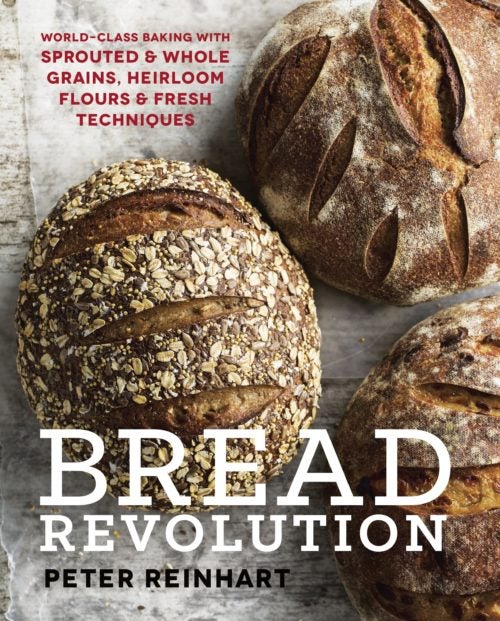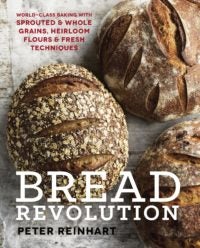



Peter Reinhart explores the rich world of bread baking in Bread Revolution.
This master dough can be used to make bread in any shape or size. It showcases the natural sweetness and tenderness of sprouted whole wheat flour without any added oil, fat, or other enrichments, such as milk, eggs, or sweeteners. Sprouting the wheat changes it so much that many of the “rules” for artisan breads, such as using pre-ferments and long, slow rising times, are unnecessary. The aims of those techniques can be achieved in less time with sprouted flour because the sprouting phase has already accomplished what pre-ferments and long fermentation typically do.
I suggest that you make this bread before attempting any of the more elaborate recipes that follow. This will familiarize you with the flavors and performance of sprouted whole wheat flour. In fact, it may be the only recipe you need for everyday breads, as it works equally well as a loaf pan bread and a crusty hearth bread.
Directions
- In the bowl of a stand mixer fitted with the paddle attachment, or in a large bowl, stir together the flour, salt, and yeast (on low speed if using a stand mixer). Add the water and mix or stir until the flour is hydrated and a coarse, wet dough forms, about 1 minute. Don’t add more flour, as the dough will thicken while it rests.
- Let the dough rest, uncovered, for 5 minutes. Then switch to the dough hook or use a wet spoon or wet hands and mix for 1 minute, on medium-low speed if using a stand mixer. The dough should be smooth but still very soft and sticky (similar to ciabatta dough). Add flour or water only if necessary to achieve that texture; the dough will firm up as you continue to work it.
- Spread about 1 teaspoon of vegetable oil or olive oil on a work surface. Using a wet or oiled bowl scraper or rubber spatula, transfer the dough to the oiled area. Lightly oil your hands, then stretch and fold the dough, folding it over itself four times: once each from the top, bottom, and sides. The dough will firm up slightly but still be very soft and somewhat sticky. Cover the dough with the mixing bowl and then, at intervals of 5 minutes or up to 20 minutes, perform three additional sequences of stretching and folding. For each stretch and fold sequence, lightly oil your hands to prevent sticking. The dough will firm up a bit more with each stretch and fold. After the final fold it should be soft, supple, and tacky and have a springy or bouncy quality when patted.
- Oil a large bowl and put the dough in the bowl. Mist the top of the dough with vegetable spray oil and cover the bowl with a lid or plastic wrap; if using plastic wrap, stretch it tightly over the bowl rather than laying it directly on the dough. Ferment the dough at room temperature for 1½ to 2 hours, until double in size. (This time can be shortened by using a warm proof box set at about 90°F.)
- Oil the work surface again and use an oiled bowl scraper or rubber spatula to transfer the dough to the oiled area. For hearth loaves, prepare two bannetons or a couche. Divide the dough in half and shape each piece into a boule or bâtard, then put the shaped loaves in the prepared proofing vessels. For pan loaves, mist two 4½ by 8-inch loaf pans with vegetable spray oil. Divide the dough in half and shape the pieces into sandwich loaves, then put the shaped loaves in the prepared pans. For rolls, line two sheet pans with parchment paper or silicone mats. Divide the dough into the desired number of pieces and shape as desired. Put half of the rolls on each lined pan.
- Mist the top of the dough with vegetable spray oil, then cover it loosely with plastic wrap. Proof for 1 to 1½ hours at room temperature, until the dough increases in size by 1½ times. When poked with a finger, it should spring back within a few seconds; if it holds the dimple, it’s risen for too long. (Because the dough is so hydrated, it’s fragile and will fall if you proof it until double in size. It’s better to bake it while it’s still on the rise.)
- To bake a hearth loaf, about 45 minutes before you plan to bake, prepare the oven for hearth baking with a baking stone and steam pan, then preheat the oven to 450°F. Transfer the shaped loaf to a floured peel (or keep it on the sheet pan for baking). Score the top as desired. Transfer the loaf onto the baking stone (or put the sheet pan on the baking stone). Pour about 1 cup of hot water into the steam pan. Bake for 15 minutes, then rotate and bake for 15 to 20 minutes longer, until the loaf is golden brown on all sides and sounds hollow when thumped on the bottom. The internal temperature should be about 200°F.Transfer to a wire rack and let cool for at least 30 minutes before slicing and serving.
- To bake pan loaves, preheat the oven to 375°F; steam is optional. Bake for 25 minutes, then rotate and bake for 25 to 40 minutes longer, until the bread is golden brown all around, the side walls are firm and not squishy, and the loaf sounds hollow when thumped on the bottom. The internal temperature should be at least 190°F. Let cool in the pans for at least 10 minutes, then transfer to a wire rack and let cool for at least 20 to 30 minutes longer before slicing and serving.
- To bake rolls, preheat the oven to 400°F; steam is optional. Bake for 12 minutes, then rotate and bake for about 10 to 15 minutes longer, until the rolls are golden brown and sound hollow when thumped on the bottom (they will soften as they cool). The internal temperature should be about 190°F. Transfer to a wire rack and let cool for at least 10 minutes before serving.
Reprinted with permission from Bread Revolution © 2014 by Peter Reinhart. Published by Ten Speed Press, an imprint of Penguin Random House, LLC.

